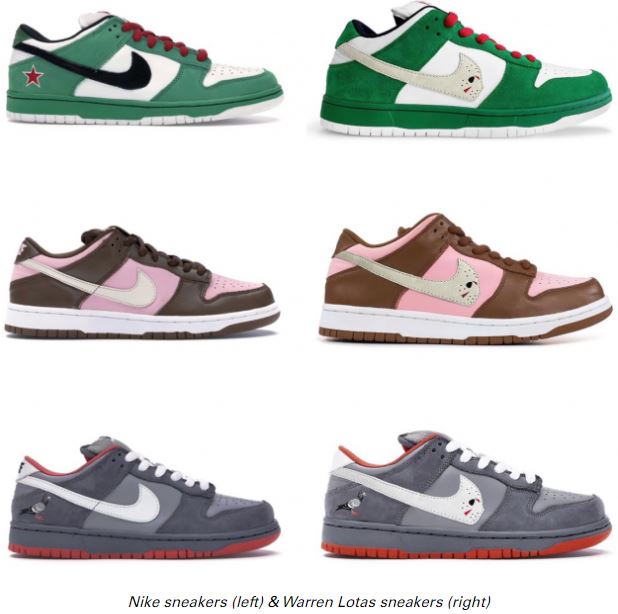A Rare Case of a Judge Relying on the Initial Interest Confusion Doctrine (Boo)–Nike v. Warren Lotas
This case involves Warren Lotas sneakers that claimed to reinterpret one of Nike’s allegedly iconic sneaker stylings. The Fashion Law summarized the case, including this depiction:
The sneaker similarities are obvious, which isn’t surprising because Warren Lotas styled its product as a “reinterpretation” of the original. The face-like design added to the swoosh is the primary and most visible difference, but there are numerous other minor differences throughout each design that I’m sure true aficionados recognize and care deeply about. For a non-aficionado like me, the similarities overwhelm the differences.
Nike sought a preliminary injunction. In response to Nike’s suit, Warren Lotas stopped taking orders and offered customers a refund or a credit towards a different sneaker, the Reaper. (It’s a little odd that Warren Lotas folded so quickly; did they not anticipate Nike’s enforcement action?).
In discussing the likelihood of Nike’s success on the merits, the court relied on the initial interest confusion doctrine (as usual, citations and parentheticals omitted):
Warren Lotas is likely to engage in initial interest confusion.
Initial interest confusion occurs when the defendant uses the plaintiff’s trademark “in a manner calculated ‘to capture initial consumer attention, even though no actual sale is finally completed as a result of the confusion’” and is actionable infringement. The Ninth Circuit in Brookfield Commc’ns, Inc. provided a helpful analogy for how initial interest confusion operates. There, the Court analyzed whether the use of a trademark in a metatag caused initial interest confusion. There, the Court analogized the use of another’s trademark in metatags to putting up a billboard with a competitor’s trademark directing potential customers to a store. The trademark on the billboard leads the potential customer to believe they are heading to a store commonly associated with that trademark. However, upon arrival, potential customers find the competitor’s store, not the store commonly associated with the trademark on the billboard. Even though the potential customer is now aware that the store they are at is not related to the trademark that originally encouraged them to seek out the store, the customer may still spend money at the store. The Ninth Circuit found that the metatags were akin to the billboard and created initial interest confusion.
The analogy applies here, too. Warren Lotas took preorders for the WL Pigeon and Broccolini, both of which contain a similar design to the Nike Swoosh design mark, and then offered a refund or a different shoe. The “billboard” in this instance is the Warren WL Pigeon and WL Broccolini, both of which likely infringe on the Nike Swoosh design mark. Warren Lotas plans on benefitting from this initial interest in the WL Pigeon and WL Broccolini by now offering the Reaper to customers who preordered the WL Pigeon or WL Broccolini. It is irrelevant that Warren Lotas has informed these customers that the Reaper is not affiliated with Nike, because the initial interest confusion attached prior to that disclaimer. The fact that preorders have been taken, but no sneakers have been distributed, is also irrelevant. Warren Lotas is benefitting from the Nike Swoosh design mark by now intending to fulfill preorders that may have been obtained through initial interest confusion.
Ugh, this made me want to cry. First, Brookfield’s billboard analogy was always terrible, and I spent several pages explaining why…15 years ago. Second, the court tries to analogize how search engines process metatags (they don’t, but Brookfield assumed they did) are like knockoff physical goods, and that stretches a terrible analogy to the breaking point. Shoes are like billboards? Really?
Third, and most importantly, the court doesn’t need to describe this phenomenon as “initial interest confusion.” Instead, the court seems to be describing standard “bait-and-switch” practices. Perhaps the court decided to rely on initial interest confusion instead because, at the time Warren Lotas made its offering, there was no intended “switch.” The alleged switch came only after Nike’s legal demand. However, the fact that the switch came later shouldn’t matter. Instead, I think the court’s choice to characterize the activity as “initial interest confusion” was a bigger doctrinal stretch than just relying on venerable bait-and-switch principles. Alternatively, you could look at this ruling as more proof that there is no such thing as “initial interest confusion;” it’s just a euphemism for bait-and-switch.
I have Westlaw alerts set up on the term “initial interest confusion.” Nowadays, I see a handful of cases every year referencing the doctrine. Most of those cases simply acknowledge that the plaintiff invoked it. It’s rare to see a court engage the doctrine substantively, and it’s extremely uncommon for a court to actually rely on the doctrine. There have only been a handful of such cases in the past half-decade. That makes this case a noticeable, and unwelcome, outlier. I tried to declare the initial interest confusion doctrine dead in 2012, and I was mostly right. Unfortunately, these sporadic anomalies spark continued but unwarranted hope among plaintiffs.
Case citation: Nike, Inc. v. Warren Lotas, 2020 WL 7264552 (C.D. Cal. Nov. 18, 2020). The complaint. The case has since settled.

Pingback: News of the Week; December 16, 2020 – Communications Law at Allard Hall()